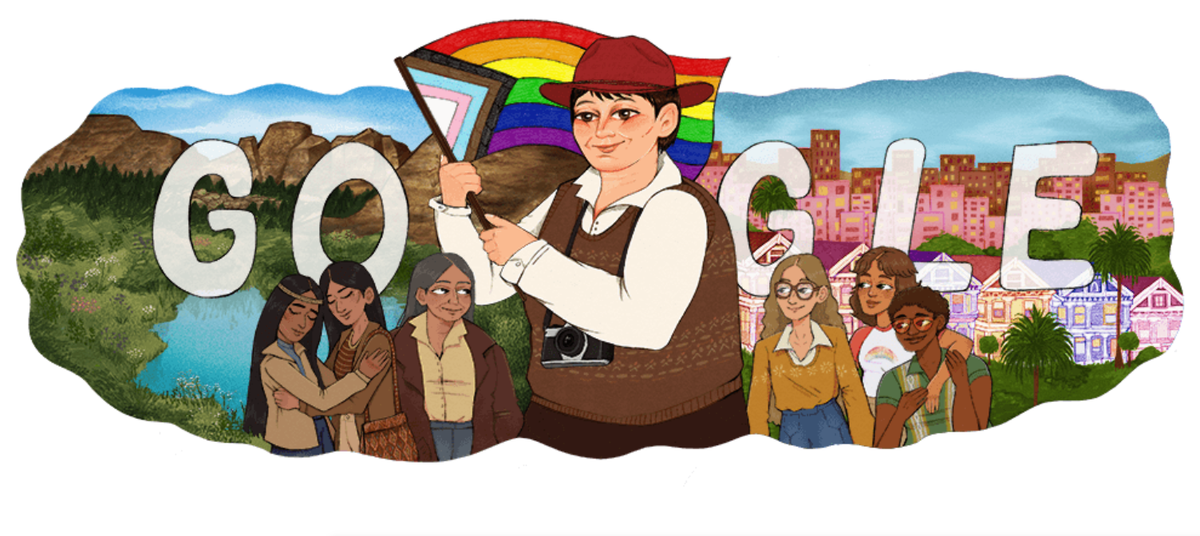
In 22 May’s Google Doodle, the website is honouring the late Barbara May Cameron on what would have been her 69th birthday.
The Google Doodle, which describes the temporary changes made to Google’s logo on special occasions, features a cartoon of the photographer with a camera hanging around her neck and holding a pride flag, as she first came out in 1973.
Behind Cameron in the drawing stands a group of women, to showcase fellow members of the LGBTQIA+ community. The backdrop is the cityscape of San Francisco, which is where she moved to after graduating college, and mountains in North Dakota, where she was born.
The Google Doodle, coming days before Pride Month begins in the US, was created by queer Mexican and Chitimachan artist Sienna Gonzales, and included Cameron’s partner, Linda Boyd-Durkee, as a collaborator on the project.
As Cameron was born on 22 May 1954, this illustration came out on what would have been her 69th birthday. Here’s everything to know about Barabara May Cameron, the late poet and advocate for the LGBTQIA+ community.
Cameron was born in Fort Yates, North Dakota, as a member of the Hunkpapa, a Native American group that was one of the seven council fires of the Lakota tribe, as noted by the Google Doodle description. After completing high school, she made her move to Santa Fe, New Mexico to study photography and film at the American Indian Art Institute.
She later moved to to San Francisco, where she became a part of many organisations that advocated for the LGBTQIA+ people in the Native American community. More specifically, in 1975, she and her friend, Randy Burns, founded the Gay American Indians, which is the first organisation that was dedicated to a Native American LGBTQIA+ group.
She went on to help organise the Lesbian Gay Freedom Day Parade and Celebration, from 1980 to 1985, and co-led a lawsuit against the Immigration and Naturalization Service. The lawsuit was against the government agency’s policy of turning away gay people, with the case ruling in favour of Cameron and her co-plaintiffs in court.
Throughout the following years, Cameron continued her work as an activist, as she became executive director at Community United Against Violence, which “supports the healing and leadership of those impacted by abuse,” as noted by the organisation’s official website. She was also appointed to the Citizens Committee on Community Development and the San Francisco Human Rights Commission by the mayor of San Francisco in 1988.
In addition, she worked towards bringing awareness to how HIV/AIDS disproportionately impacted Native Americans. She was an active member of San Francisco AIDS Foundation and the American Indian AIDS Institute throughout the ‘90s.
Following her death in 2002, she has continued to be remembered through her writing. In 1996, her essay No Apologies: A Lakota Lesbian Perspective was featured in Our Right To Love: A Lesbian Resource Book.
In a statement to Google, Cameron’s partner spoke out about the artist dedicated to social justice. She noted that while Cameron was a busy activist throughout her life, she also had a kind heart, which showed as they raised their son, Rhys, together.
“She liked to set up her son Rhys to “shock” his mom (Linda Boyd) with language some people would punish,” Boyd-Durkee explained. “She understood how a kid would love to be able to say a curse word, because she was still a kid at heart.
She continued: “While recovering from back surgery, she enjoyed Rhys’ video games. She was an excellent bridge player and a great cook; we spent whole weekends at rented houses in Bodega Bay, California, playing bridge, cooking and eating with friends on the beautiful Pacific coast.”







